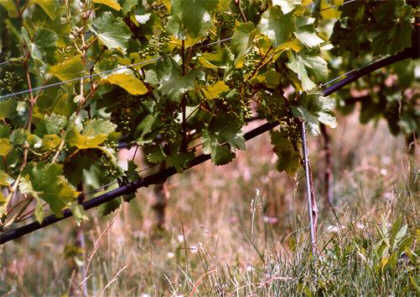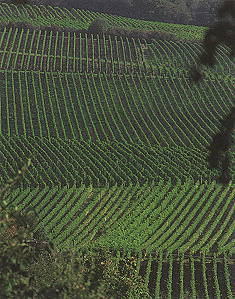in Kiedrich, he sees the Gräfenberg, one of the best vineyards in the Rheingau. The grapes that ripen here provide the
expensive and sought-after in the world. This year could even produce something extraordinary in the Gräfenberg: a vintage of the century. "Ripeness already set in for
at the beginning of August," says Weil. "Around four weeks earlier than usual."
But the downside of the beautiful summer manifests itself in drought stress. "In the particularly steep sites, where the soils are not so deep, I can already see one or two yellow leaves," says Weil. "Two or three intense land rains would do wonders."
A few kilometres east of Gräfenberg, this "miracle" manifests itself in a mundane sound. A garish squeak resounds through the vines on the Rauenthaler Berg. Stefan
Seyffardt opens the blue-painted water tap of the small supply station with nimble hand movements. The black plastic hoses of the drip irrigation system under the vines fill with groundwater - slowly, drop by drop, the water trickles onto the previously dry soil.
For the manager of the Hessian State Domain Rauenthal, reaching for the tap in the vineyard is almost an everyday routine these days. The sweltering heat is almost oppressive and sweat is pouring off Seyffardt's forehead. Nevertheless, he is happy about "Californian conditions" in his vineyards and about "a third more hours of sunshine compared to 1976."
1976 - a magical year for German
winegrowers, the last great vintage of the century. "But back then it rained every now and then,"
Seyffardt recalls. Unlike this summer, when it remained mostly dry.
If there were an occasional downpour, this, in combination with the favourable sunshine, could certainly cause great things to ripen in the vineyards along the Rhine. The
winegrowers are registering a four-week advance in the ripening of the vines. This is unique since weather records began in the middle of the 19th century. "For
Müller-Thurgau, the
harvest could begin as early as the end of August and for
Riesling in mid-September," predicts Stefan Seyffardt.
Such an early
harvest date would be a historical peculiarity. "The earliest
harvest time for
Riesling so far was at the end of September in 1827," says physicist Dr Manfred Stock of the Potsdam Institute for
Climate Impact Research (PIK). The Potsdam scientists have analysed the archives of
Schloss Johannisberg and other vineyards in the
Rheingau and have been
able to trace the respective start of the
harvest back to 1780.
The cooperation between
climate research and wine science has a long tradition because, for example, the beginning of the grape
harvest provides important insights into the course of the
climate in earlier decades and centuries. "The changes observed in
viticulture are often used as indicators of
climate change," says Stock. "In southern
England, the economically used area under vine has more than doubled in the last 15 years," says the
climate researcher. Overall, the nineties were the warmest decade within the 20th century: "Budding, flowering and ripening of the grapes have since occurred earlier in the year in many cases."
This trend is likely to continue. The Potsdam scientists have developed a
climate scenario up to the year 2050, based on detailed weather records of the period from 1951 to 2000 and the predicted trend of global warming. The result: "In the case of
Riesling, we calculate that
harvest maturity will start 10 to 14 days earlier in the next 50 years," says physicist Manfred Stock from PIK. The average temperature in the
Rheingau could rise by two degrees by then. "At least in summer, we would then have Mediterranean conditions there," Stock says.
How this development could affect yields and quality is still a matter of debate. At least in the case of
Riesling, the universally appreciated acid component could suffer from the higher temperatures. But Professor Hans-Reiner Schultz of the University of Applied Sciences for
Viticulture in
Geisenheim remains calm: "So far, the warmest years have also been the best
Riesling years, so the optimum has not yet been reached."
But warmth-loving grapes are already being cultivated on an experimental basis at the Hessian State Wine Estates: the red
Merlot on the Bergstrasse and the white
Chardonnay in the Rheingau. Even
Cabernet Sauvignon could soon become an issue, says PIK researcher Stock. This reinforces a trend that has been going on in Germany's vineyards for several years now: Many
winegrowers are increasingly opting for red wine at the expense of white wine.
Keeping
options open is therefore the motto in the future - and don't lose sight of day-to-day business. Because the driest months in the
Rheingau, August and September, are still to come. Stefan
Seyffardt of the Hessische Staatsdomäne Rauenthal feels prepared because the well in the Rauenthaler Berg holds enough groundwater.
Therefore, yellow leaves on the vines as an unmistakable sign of drought
stress are nowhere to be
seen in the Rauenthal "Gehrn" steep slope. A well feeds the drip irrigation system from the depths of the Rauenthal mountain. The hoses are attached to the vines 20 centimetres above the ground. Every second, the water
drops spill out and wet the previously dust-dry soil - two litres per hour for each vine. The moisture spreads through the root zone of the vines in the shape of an onion.

|
|
The soil is wetted every second. Photo: Netafim
|
Bernd Gruber from the University of Applied Sciences for
Viticulture in
Geisenheim had previously determined the moisture content of individual leaves with a transportable, cylindrical, approximately 20-centimetre-long pressure chamber made of stainless steel. For three hours, the water is now to seep into the root space of the vines. Gruber has to get up early for his measurements. He always measures in the morning before sunrise, because the
assimilation activity of the vine plants is at rest during the night and then there is a large degree of equilibrium between soil moisture and the water content of the vine. "This is the only way I can obtain unbiased information and correctly dimension the watering," says Gruber. Gruber always calculates the amount of water very tightly so that the vine does not "drown" the next day if a summer thunderstorm should hit the vineyard.
The
Geisenheim wine researchers have been experimenting with this since 2001, so far with meagre results. "The past two years were simply not dry enough to get clear signals," regrets Professor Hans-Reiner Schultz, head of the
viticulture department in Geisenheim. It is true that the
Riesling in the irrigated plots would have reached higher
Öchsle degrees and thus higher must weights than in the control plots that remained dry. This ripeness-dependent natural sugar content in the must is still the
most important quality criterion for German wines. "But sugar is not everything," Schultz qualifies. "After all, irrigation should also have a favourable effect on the development of
aroma substances," the biologist demands.
The
winegrowers in the
Rheingau follow the scientists' work with interest. They hardly have any experience with irrigation. "We have only ever irrigated our new plantings before the
first year of yield," says Wilhelm Weil. For the vines in the yield areas, the question of an additional watering from the hose had not arisen either. As a rule, it had rained too much, rarely too little. Moreover, the dry years were the best wine years. "A low water level in the Rhine usually meant a good wine year,"
Wilhelm Weil points to a parallel from the history of
viticulture in the Rheingau.
The director of the "Robert Weil" winery in Kiedrich hopes that the
Geisenheim researchers will provide answers to the crucial questions: When is the optimal time for irrigation? And how much water should be given so that the plant still benefits but the yields remain low? Because if you water your vines too much, you will
harvest lots of fat grapes, but this quantity on the vine will be at the expense of the quality in the glass. Only those who reduce yields bring high-quality wine into the barrels: "Our vines are allowed to starve a little so that they produce special qualities - with small berries that are aromatic and intense in taste," says Wilhelm Weil.
Weil is one of those quality winemakers in Germany who have made the worldwide renaissance of
German Riesling wines possible by consistently reducing yields in the vineyard. "When the vine is starved, it develops a deeper root system in the soil in the long term, which promotes the minerality of the wines," says Weil.
Nevertheless, Weil welcomes well-dosed irrigation that optimises top qualities while avoiding severe drought
stress on the vine. Experiences from South Africa, California or Australia - where vintners routinely water their vines - are of only limited help in Germany. Watering must always be geared to the small-scale local conditions in the vineyard. Even in the
Rheingau, it is important to differentiate. "The stony and shallow slate soil on the steep
Rüdesheimer Berg needs water every third day in the current sweltering heat," says Stefan Seyffardt. On the Rauenthaler Berg, on the other hand, the soil can hold water much better thanks to its loess content. Therefore,
Seyffardt does not have to turn on the tap there so often.
Drought in the vineyard often results in a dreaded phenomenon: UTA. This abbreviation stands for "atypical ageing notes". Especially the
aroma varieties
Müller-Thurgau and
Riesling age too quickly, often as early as six months after fermentation. The wine then has a pale, watery colour. It does not develop its varietal fruit and freshness, but smells dull and mouldy like wet cardboard, sackcloth or even moth powder, and tastes dull and bitter. "The causes of this wine defect have not yet been clearly researched, but water and nutrient deficiencies during crucial phases of
vegetation development are likely to be a
main reason," says Berthold
Steinberg from the
viticulture department in Geisenheim. "Too high yields with too low must weights and a too early
harvest are also being discussed."
It is possible that this hot, dry summer is causing the fear of
UTA to grow among winegrowers. The installation of drip irrigation would require investment costs of up to 5,000 euros per hectare. But hardly any
winegrowers have wells that hold groundwater for their vineyards. And with increasing drought, even these supplies would be limited. So the question would remain, where would the water come from? From the Rhine? Then it would have to be pumped up the vineyards with a
lot of energy. From the waterworks? That would be too expensive in the long run, says Hans-Reiner Schultz: "We need up to 60,000 litres per hectare and irrigation run, and then maybe six or seven times a year.
Large reservoirs would probably have to be built above the vineyards to catch much of the precipitation in winter and spring.
Rainwater for a dry, blazing hot summer like this one. Stefan
Seyffardt turns off the tap again in the middle of the vineyards on the Rauenthaler Berg. The water supply should be enough for the next few days. Like all vintners,
Seyffardt hopes for the great vintage of the century.
Wilhelm Weil is also confident when he looks up at "his" Gräfenberg. At the same time, he urges restraint: "At the end of the day, there's always a reckoning, and even the best wine can still tip over in the glass.

